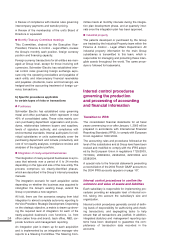APC 2004 Annual Report Download - page 37
Download and view the complete annual report
Please find page 37 of the 2004 APC annual report below. You can navigate through the pages in the report by either clicking on the pages listed below, or by using the keyword search tool below to find specific information within the annual report.
35
Intangible assets
The value of software corresponds essentially to
licenses and development costs. These costs are cap-
italized only when the amounts incurred during the
various phases of the project have been validated and
documentary evidence is available confirming that the
application has been put in production.
In connection with the transition to IFRS, the Group
has improved its systems for tracking expenditure on
development projects, in order to identify costs that
can be capitalized and more accurately measure the
profitability of new products.
The carrying value of trademarks is determined
based on an assessment of the economic value of the
underlying business at the time of acquisition and on
an independent valuation of the trademark.
Goodwill corresponds to the difference between the
cost of shares in a consolidated company and the fair
value of the acquired assets and liabilities, as deter-
mined by the Finance & Control - Legal Affairs
Department. The amortization period of goodwill is
determined based on the projected future earnings of
the acquired business and its positioning within the
Group. A joint review of the present value of assets is
performed at each year-end by the units and the
Finance & Control - Legal Affairs Department. If the
net book value of goodwill-corresponding to the gross
amount less accumulated straight-line amortization-is
overstated, an allowance for impairment in value is
recorded. In connection with the adoption of IFRS,
goodwill will be tested for impairment at each year-
end, starting in 2004.
Property, plant and equipment
Land and buildings are stated at historical cost net of
accumulated depreciation and any impairment loss-
es. Manufacturing assets are tracked by the Global-
ization & Industry Division.
Property, plant and equipment are recognized in the
accounts on the basis of title deeds or an invoice
accompanied by documentary evidence that the
asset has been put into service.
Investments
Investments in consolidated companies and invest-
ments carried at cost are tracked and verified by the
Legal and Consolidation teams within the Finance &
Control - Legal Affairs Department.
Inventories
The transition to IFRS has provided an opportunity to
check that all subsidiaries apply the same policies
concerning the types of costs included in the carrying
value of inventories.
Physical inventories are carried out by all subsidiaries.
Inventories are written down to net realizable value
where appropriate.
Trade receivables
When sales are recorded in the accounts by the sub-
sidiaries, this automatically generates an entry in a
trade receivables account. Receivables are valued
and–where appropriate–written down by the sub-
sidiaries in accordance with Group policies.
Accrued taxes
The subsidiaries are responsible for calculating,
accruing and managing their taxes, except in some
cases where the subsidiary concerned is a member
of a tax group.
The Tax unit within the Finance & Control - Legal
Affairs Department reviews the current tax charge.
Originally, these checks were performed mainly for
French tax, but they are now also carried out on the
tax charge reported by the Group's main internation-
al subsidiaries, essentially in the European Union and
the United States. The Tax unit is also responsible for
overseeing the resolution of tax claims.
The Statutory and Management Accounting unit with-
in the Finance & Control - Legal Affairs Department
performs six-month reviews of the Group's current and
deferred tax position. The procedure includes perform-
ing analytical reviews of the main subsidiaries' tax
position, preparing the tax proof validating the Group's
effective tax rate, and analyzing changes in deferred
tax assets and liabilities by category of tax basis.
Provisions for contingencies and charges
Group policy consists of recording provisions for con-
tingencies and charges in the accounts of the individ-
ual subsidiaries. Claims and litigation are generally
managed jointly by the subsidiary and the Finance &
Control - Legal Affairs Department.
Provisions for contingencies are adjusted to reflect
any changes in the estimated risk. Movements
recorded by subsidiaries are required to be evidenced
and are checked for compliance with the applicable
accounting standards. The transition to IFRS has pro-
vided the Group with an opportunity to perform a
detailed review of the provisions booked by sub-
sidiaries and to ensure that balance sheet presenta-
tion rules are applied consistently.
Provisions for pensions
and other post-retirement benefit obligations
The subsidiaries are responsible for managing their
employee benefit obligations under compulsory and
company-sponsored plans. Group policy consists of
systematically recording provisions for statutory
length-of-service awards due to employees on retire-
ment, pensions and healthcare costs paid on behalf
of retired employees in all countries where the Group
has an obligation under the related plans. These obli-
gations are reviewed annually by the Finance &
Control - Legal Affairs Department.
In connection with the transition to IFRS, in 2004 the
Finance & Control - Legal Affairs Department per-
formed a comprehensive review of subsidiaries' ben-
efit obligations.
Corporate Governance
























